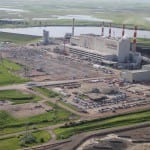Norway’s government on Friday terminated a full-scale project to capture carbon dioxide at the Mongstad refinery on the country’s western coast, citing high risks connected to the facility. It will be replaced with a carbon capture and storage (CCS) program that is designed to “realize” other full-scale CCS projects in the country.
Norwegian energy firm Statoil and Norway’s Ministry of Petroleum and Energy signed an implementation agreement and later submitted a master plan for a full-scale carbon capture project at Mongstad in 2006. The goal was to capture exhaust gases from a residue catalytic cracker and 280-mwe (350-mwt) combined heat and power (chp) natural gas–fired plant on the site. The project included CO2 routes linking the retrofitted capture plant to potential storage sites in offshore deep saline formations. A final decision on the full-scale project was expected in 2016, and full-scale collection of CO2 was anticipated to begin in 2020.
Project partners Gassnova, Shell, and Sasol in May 2012 opened the CO2 Technology Centre Mongstad (TCM), a facility that tests and demonstrates technologies for capturing the greenhouse gas. The government’s goal for the technology center is to make it “an arena for long-term, targeted development, testing, and qualification of technology for CO2 capture.”
But on Friday, the Ministry of Petroleum and Energy said it was changing the direction of its commitment to CCS by discontinuing the full-scale project at Mongstad. “A full-scale CO2 capture facility is still the objective. The government has, however, concluded, after careful consideration, that the risk connected to the Mongstad facility is too high and has for that reason decided that the work on the full-scale facility will be discontinued,” said Minister of Petroleum and Energy Ola Borten Moe.
Moe said integrating a full-scale capture facility at Mongstad would be “both challenging and costly.” He pointed out that uncertainty of the project has increased as “the refinery industry in Northwest Europe is currently facing a hard time. At the same time, the development of the capture facility is now reaching a new phase, in which continuation would entail high costs.”
Among factors affecting the viability of the project are that the low price of carbon emissions and the economic recession in most of Europe had “reduced commercial interest for CCS,” he said. As POWERnews reported, the ministry in 2010 expressed concerns about possible health and environmental risks related to amine technology and had evaluated alternative solutions to capture carbon from the refinery’s existing catalytic cracker facility and adjacent CHP plant. Project partner Gassnova has said it believed the risk related to the amine technology was “manageable.”
The TCM will be continued and “strengthened” with an injection of $67 million over four years, but the government’s revised strategy now includes a program to ensure the financial and other conditions necessary to result in at least one such project by 2020—as agreed to in a bi-partisan climate agreement reached by the Norwegian parliament. “To achieve this, appropriate incentive structures, securing a clear and sensible risk division between the state and industry are necessary. In order to qualify for funding, projects will have to contribute considerably to the development of technology and also be relevant for the development of further projects,” the ministry said. The government also expects to increase allocations for CCS research and development by $16 million.
Statoil, which owns the complex comprised of a refinery, a natural gas liquids fractionation plant, and a crude oil terminal, on Friday said work carried out at the CCS project has been “extensive and demanding.” The company said, however, that the experience gained at Mongstad “indicates that it is necessary to intensify the work being done to develop the technology and reduce the cost involved in so doing.”
Statoil had completed several initial tests at the Mongstad carbon capture project, including degree-of-capture verification as well as energy efficiency tests. It had planned to analyze that data this fall. “We have developed the tools required to analyze the emissions and we believe we can now be sure that the technology can be applied in a full-scale capture plant,” said the company, which was poised to enter the project phase next year to include prequalification and competitive tendering in connection with a concept choice.
Sources: POWER, Norwegian Ministry of Petroleum and Energy, Statoil
—Sonal Patel, associate editor (@POWERmagazine, @sonalcpatel)









